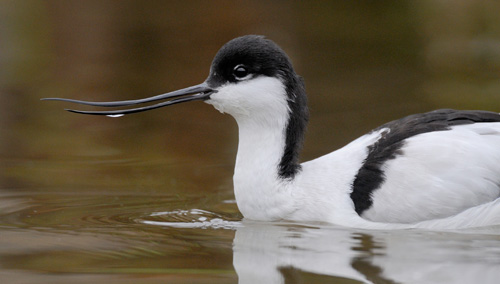
We decided to spend our last day at Pensthorpe near Fakenham. An interesting choice and one governed by a number of factors, not least of which it being a convenient place to have a hire car delivered! We had traveled from South Wales together in the same car, it gives a chance to catch up and plan the days ahead and have a laugh and joke, as brothers will! Traveling over night, as we always do, alleviates the traffic, although I was amazed at how busy the M25 is at 4.00am! On the way back we were going our separate ways, Phil back to Barrow and me to Llantrisant. Pensthorpe would also give the opportunity of working with some British birds in the aviaries at the reserve.

It was my first visit and I was curious to see birds such as Avocet, Black-tailed Godwit and Little Egret at really close range. The Pensthorpe Conservation Trust, established in 2003, works with the RSPB and WWT on various programmes related to ecological restoration. One of its main areas of conservation is in the captive breeding of threatened wetland species along with sustainable farming, habitat restoration and land management. It has also recently hosted the popular natural history epic that is Springwatch.

Being a dank and dismal December day, it was never going to be busy, and this certainly made the experience more enjoyable. I was really impressed by the whole place and with the cooperation of the staff, we had asked them if they would mind informing us when the hire car was delivered! The aviary birds allow some really intimate moments between species that would be difficult to experience in the wild. An Avocet will swim within a few feet of you; a Little Egret stares directly at you from a tree not four feet way! It’s a chance to look at bird anatomy in a way not normally possible.

I have no problem in photographing captive birds. It is still a waiting game, not so much for the bird but the position it is in and the behaviour it displays. The avairies are effectively open, if it rains it rains on the birds and the environment ,while a little artificial in places, can be worked to your advantage. Whenever I use the images from a captive bird situation they are always captioned with a very clear ‘cb’, captive bird, so there is no ambiguity in how or where the images where taken.

The beauty of Pensthorpe, though, are the hides and the wild areas within the reserve that are managed as any natural habitat would be. We walked around the grounds and into the hides, it was all very quiet, not really surprising with the weather as it was, but with obvious potential.

The reserve boasts 171 wild bird recordings and coupled with the opportunities of photographing some of the captive birds it’s a good day out. Such places can also be wonderful for trying out new techniques or honing your skills. Any aspiring photographer should take advantage of any situation where birds congregate; local parks, sea fronts and the likes of Pensthorpe and the WWT reserves, where I run some of my courses, are ideal places to learn the nuances of photography.

I left Pensthorpe at a quarter to five and took the cross country route via Kings Lynn, Peterborough, Northampton and Oxford before joining familiar territory at the M4. With a motorway closure due to an accident near Oxford and fog on the M4 it took rather longer than I had hoped. The 275 miles, five miles shorter than Phil’s journey to Barrow, took a little longer than I had hoped but it was well worth the effort and next time we may strike lucky with the weather! We hope to visit the Somerset levels in the new year and explore an area we haven’t visited for many years.

All the images in this blog are captive birds.
